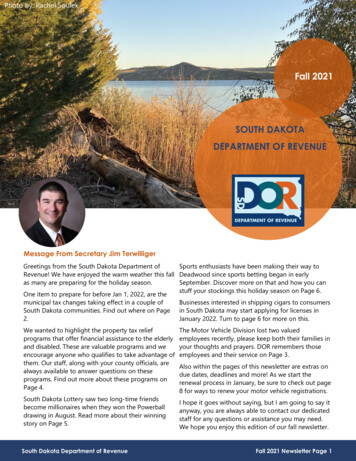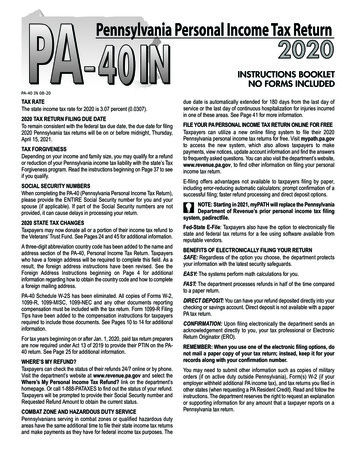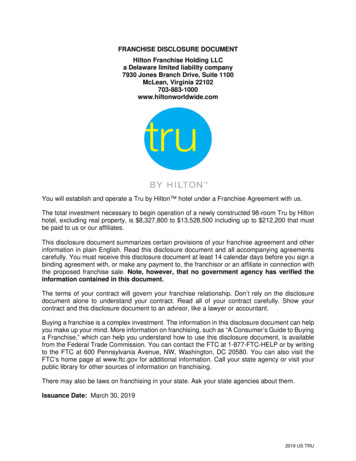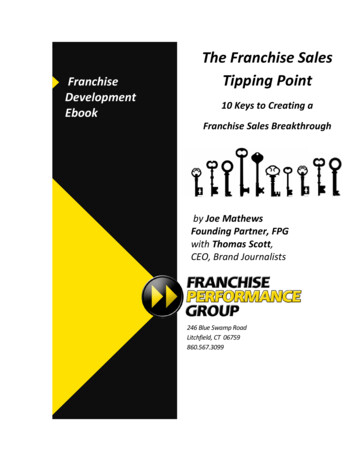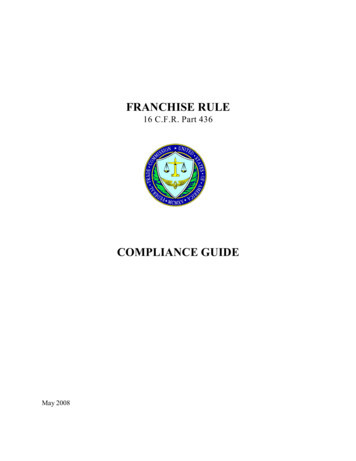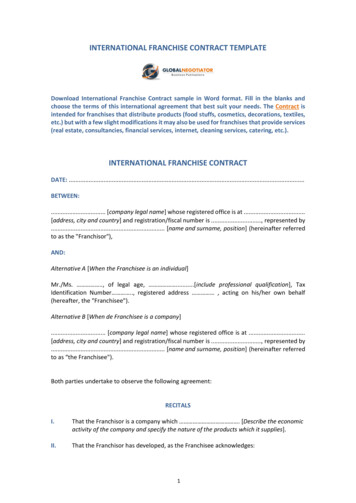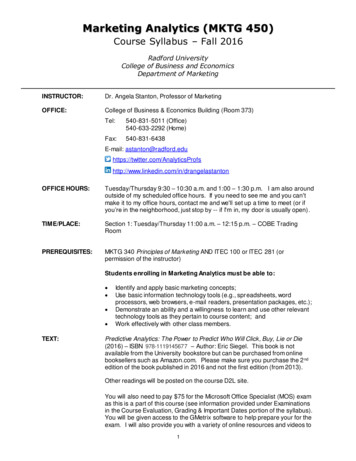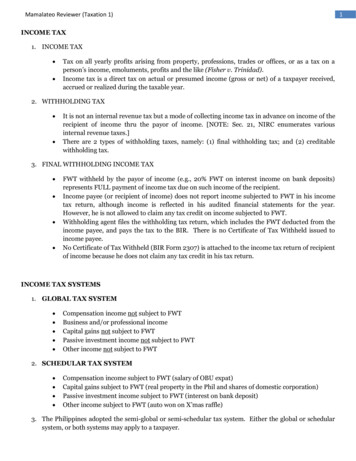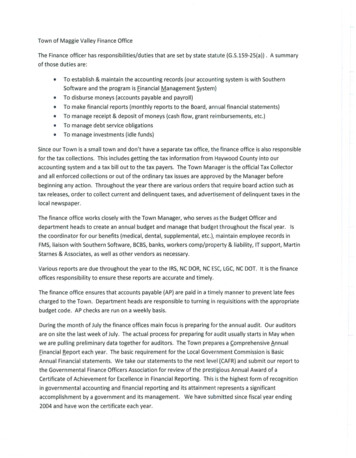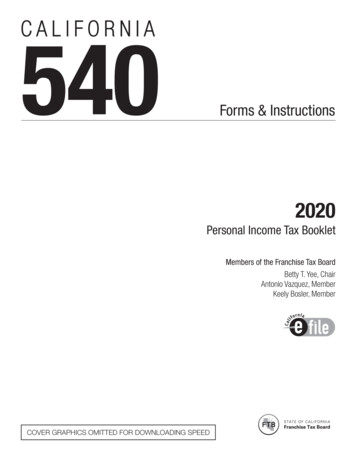
Transcription
CALIFORNIA540Forms & Instructions2020Personal Income Tax BookletMembers of the Franchise Tax BoardBetty T. Yee, ChairAntonio Vazquez, MemberKeely Bosler, MemberCOVER GRAPHICS OMITTED FOR DOWNLOADING SPEED
Table of ContentsImportant Dates . . . . . . . . . . . . . . . . . . . . . . . . . . . . . . . . . . . . . . . . . .Do I Have to File? . . . . . . . . . . . . . . . . . . . . . . . . . . . . . . . . . . . . . . . . .What’s New and Other Important Information for 2020 . . . . . . . . . . . .Which Form Should I Use? . . . . . . . . . . . . . . . . . . . . . . . . . . . . . . . . .Instructions for Form 540 . . . . . . . . . . . . . . . . . . . . . . . . . . . . . . . . . .Nonrefundable Renter’s Credit Qualification Record . . . . . . . . . . . . . .Voluntary Contribution Fund Descriptions . . . . . . . . . . . . . . . . . . . . . .Credit Chart . . . . . . . . . . . . . . . . . . . . . . . . . . . . . . . . . . . . . . . . . . . . .Frequently Asked Questions . . . . . . . . . . . . . . . . . . . . . . . . . . . . . . . . .Additional Information . . . . . . . . . . . . . . . . . . . . . . . . . . . . . . . . . . . . .Instructions for Filing a 2020 Amended Return . . . . . . . . . . . . . . . . . .Form 540, California Resident Income Tax Return . . . . . . . . . . . . . . .Schedule CA (540), California Adjustments — Residents . . . . . . . . . .Instructions for Schedule CA (540) . . . . . . . . . . . . . . . . . . . . . . . . . . .Schedule D (540), California Capital Gain or Loss Adjustment . . . . . .Instructions for Schedule D (540) . . . . . . . . . . . . . . . . . . . . . . . . . . . .Important Dates234892122232425272935394951FTB 3519, Payment for Automatic Extension for Individuals . . . . . . . .Form 540-ES, Estimated Tax for Individuals . . . . . . . . . . . . . . . . . . . .Instructions for Form 540-ES . . . . . . . . . . . . . . . . . . . . . . . . . . . . . . .FTB 3506, Child and Dependent Care Expenses Credit . . . . . . . . . . . .Instructions for Form FTB 3506 . . . . . . . . . . . . . . . . . . . . . . . . . . . . .FTB 3514, California Earned Income Tax Credit . . . . . . . . . . . . . . . . . .Instructions for Form FTB 3514 . . . . . . . . . . . . . . . . . . . . . . . . . . . . .2020 California Tax Table . . . . . . . . . . . . . . . . . . . . . . . . . . . . . . . . . . .2020 California Tax Rate Schedules . . . . . . . . . . . . . . . . . . . . . . . . . . .How To Get California Tax Information . . . . . . . . . . . . . . . . . . . . . . . . .Franchise Tax Board Privacy Notice on Collection . . . . . . . . . . . . . . . .Automated Phone Service . . . . . . . . . . . . . . . . . . . . . . . . . . . . . . . . . .535659636569738793949495When the due date falls on a weekend or holiday, the deadline to file and pay without penalty is extended to the next business day.April 15, 2021*Last day to file and pay the 2020 amount you owe to avoid penalties and interest.*See form FTB 3519 for more information.*If you are living or traveling outside the United States on April 15, 2021, the dates for filing your tax return and payingyour tax are different. See form FTB 3519 for more information.October 15, 2021Last day to file or e-file your 2020 tax return to avoid a late filing penalty and interest computed from the original due dateof April 15, 2021.April 15, 2021June 15, 2021September 15, 2021January 18, 2022The dates for 2021 estimated tax payments. Generally, you do not have to make estimated tax payments if the total of yourCalifornia withholdings is 90% of your required annual payment. Also, you do not have to make estimated tax payments ifyou will pay enough through withholding to keep the amount you owe with your tax return under 500 ( 250 if married/registered domestic partner (RDP) filing separately). However, if you do not pay enough tax either through withholdingor by making estimated tax payments, you may have an underpayment penalty. See Form 540-ES instructions for moreinformation. for YouEarned Income Tax Credit Federal Earned Income Tax Credit (EIC) – EIC reduces your federaltax obligation, or allows a refund if no federal tax is due. You mayqualify if you earned less than 50,954 ( 56,844 if married filingjointly) and have qualifying children or you have no qualifyingchildren and you earned less than 15,820 ( 21,710 if marriedfiling jointly). Go to the Internal Revenue Service (IRS) website atirs.gov/taxtopics and choose topic 601, get the federal income taxbooklet, or go to irs.gov and search for eitc assistant. California Earned Income Tax Credit (EITC) – EITC reduces yourCalifornia tax obligation, or allows a refund if no California tax is due.You may qualify if you have wage income earned in California and/ornet earnings from self-employment of less than 30,001. You donot need a child to qualify. For more information, go to ftb.ca.govand search for eitc or get form FTB 3514, California Earned IncomeTax Credit.Young Child Tax Credit Young Child Tax Credit (YCTC) – YCTC reduces your California taxobligation, or allows a refund if no California tax is due. You mayqualify for the credit if you qualified for the CA EITC and you haveat least one qualifying child who is younger than six years old asof the last day of the taxable year. For more information, see theinstructions for Form 540, line 76, and get form FTB 3514.Refund of Excess State Disability Insurance (SDI) – If you worked forat least two employers during 2020 who together paid you more than 122,909 in wages, you may qualify for a refund of excess SDI. See theinstructions on page 15.Common Errors and How to Prevent ThemHelp us process your tax return quickly and accurately. When we find anerror, it requires us to stop to verify the information on the tax return,which slows processing. The most common errors consist of: Claiming the wrong amount of estimated tax payments. Claiming the wrong amount of standard deduction or itemizeddeductions. Claiming a dependent already claimed on another return. The amount of refund or payments made on an original return doesnot match our records when amending your tax return.Page 2Personal Income Tax Booklet 2020 Claiming the wrong amount of withholding by incorrectly totaling ortransferring the amounts from your federal Form W-2, Wage and TaxStatement. Claiming the wrong amount of real estate withholding. Claiming the wrong amount of SDI. Claiming the wrong amount of exemption credits.To avoid errors and help process your tax return faster, use these helpfulhints when preparing your tax return.Claiming estimated tax payments: Verify the amount of estimated tax payments claimed on your taxreturn matches what you sent to the Franchise Tax Board (FTB) forthat year. Go to ftb.ca.gov and login or register for MyFTB to viewyour total estimated tax payments before you file your tax return. Verify the overpayment amount from your 2019 tax return yourequested to be applied to your 2020 estimated tax.Claiming state disability insurance: Verify the amount of SDI used to figure the amount of excess SDIclaimed on Form 540, line 74, matches amounts from your W-2’s.Claiming standard deduction or itemized deductions: See Form 540, line 18 instructions and worksheets for the amount ofstandard deduction or itemized deductions you can claim.Claiming withholding amounts: Go to ftb.ca.gov and login or register for MyFTB to verify withheldamount or see instructions for line 71 of Form 540. Confirm onlyCalifornia income tax withheld is claimed. Verify real estate or other withholding amount from Form 592-B,Resident and Nonresident Withholding Statement, and Form 593,Real Estate Withholding Statement. See instructions for line 73 ofForm 540.Claiming refund or payments made on an original return whenamending your tax return: Go to ftb.ca.gov and login or register for MyFTB to check tax returnrecords for refund or payments made. Verify the amount from your original return Form 540, line 115 andinclude any adjustment by FTB.Use e-file: By using e-file, you can eliminate many common errors. Go toftb.ca.gov and search for efile options.
Do I Have to File?Steps to Determine Filing RequirementStep 3: If your income is less than the amounts on the chart you maystill have a filing requirement. See “Requirements for Children withInvestment Income” and “Other Situations When You Must File.” Dothose instructions apply to you? If yes, you have a filing requirement. Ifno, go to Step 4.Step 4: Are you married/RDP filing separately with separate propertyincome? If no, you do not have a filing requirement. If yes, prepare a taxreturn. If you owe tax, you have a filing requirement.Step 1: Is your gross income (all income received from all sources in theform of money, goods, property, and services that are not exempt fromtax) more than the amount shown in the California Gross Income chartbelow for your filing status, age, and number of dependents? If yes, youhave a filing requirement. If no, go to Step 2.Step 2: Is your adjusted gross income (federal adjusted grossincome from all sources reduced or increased by all California incomeadjustments) more than the amount shown in the California AdjustedGross Income chart below for your filing status, age, and number ofdependents? If yes, you have a filing requirement. If no, go to Step 3.On 12/31/20,my filing status was:California Gross IncomeDependentsand on 12/31/20,my age was:(If your 65th birthday is on January 1,2021, you are considered to be age 65 onDecember 31, 2020)012or moreCalifornia Adjusted Gross IncomeDependents201or moreSingle orHead of householdUnder 6565 or 99727,56430,57237,13938,232Married/RDP filing jointlyMarried/RDP filing separatelyUnder 65 (both spouses/RDPs)65 or older (one spouse/RDP)65 or older (both 57451,94153,03459,234Qualifying widow(er)Under 6565 or olderAny age(The income of both spouses/RDPs mustbe combined; both spouses/RDPs may berequired to file a tax return even if only onespouse/RDP had income over the amountslisted.)Dependent of another personAny filing ,232More than your standard deduction (Use the California Standard DeductionWorksheet for Dependents on page 11 to figure your standard deduction.)Requirements for Children with Investment IncomeCalifornia law conforms to federal law which allows parents’ election toreport a child’s interest and dividend income from children under age 19or a student under age 24 on the parent’s tax return. For each childunder age 19 or student under age 24 who received more than 2,200 ofinvestment income in 2020, complete Form 540 and form FTB 3800, TaxComputation for Certain Children with Unearned Income, to figure thetax on a separate Form 540 for your child.If you qualify, you may elect to report your child’s income of 11,000 orless (but not less than 1,100) on your tax return by completing formFTB 3803, Parents’ Election to Report Child’s Interest and Dividends.To make this election, your child’s income must be only from interestand/or dividends. To get forms FTB 3800 or FTB 3803, see “Order Formsand Publications” or go to ftb.ca.gov/forms.Other Situations When You Must FileIf you have a tax liability for 2020 or owe any of the following taxes for2020, you must file Form 540. Tax on a lump-sum distribution. Tax on a qualified retirement plan including an Individual RetirementArrangement (IRA) or an Archer Medical Savings Account (MSA). Tax for children under age 19 or student under age 24 who haveinvestment income greater than 2,200 (see paragraph above). Alternative minimum tax. Recapture taxes. Deferred tax on certain installment obligations. Tax on an accumulation distribution from a trust.Filing StatusUse the same filing status for California that you used for your federalincome tax return, unless you are a registered domestic partnership(RDP). If you are an RDP and file single for federal, you must filemarried/RDP filing jointly or married/RDP filing separately for California.If you are an RDP and file head of household for federal purposes, youmay file head of household for California purposes only if you meetthe requirements to be considered unmarried or considered not in adomestic partnership.Exception: If you file a joint tax return for federal purposes, you may fileseparately for California if either spouse was either of the following: An active member of the United States armed forces or any auxiliarymilitary branch during 2020. A nonresident for the entire year and had no income from Californiasources during 2020.Community Property States: If the spouse earning the Californiasource income is domiciled in a community property state,community income will be split equally between the spouses. Bothspouses will have California source income and they will not qualifyfor the nonresident spouse exception.If you had no federal filing requirement, use the same filing status forCalifornia that you would have used to file a federal income tax return.If you filed a joint tax return and either you or your spouse/RDP wasa nonresident for 2020, file Form 540NR, California Nonresident orPart-Year Resident Income Tax Return.SingleYou are single if any of the following was true on December 31, 2020: You were not married or an RDP. You were divorced under a final decree of divorce, legally separatedunder a final decree of legal separation, or terminated your registereddomestic partnership. You were widowed before January 1, 2020, and did not remarry orenter into another registered domestic partnership in 2020.Married/RDP Filing JointlyYou may file married/RDP filing jointly if any of the following is true: You were married or an RDP as of December 31, 2020, even if youdid not live with your spouse/RDP at the end of 2020. Your spouse/RDP died in 2020 and you did not remarry or enter intoanother registered domestic partnership in 2020. Your spouse/RDP died in 2021 before you filed a 2020 tax return.Married/RDP Filing Separately Community property rules apply to the division of income if youuse the married/RDP filing separately status. For more information,get FTB Pub. 1031, Guidelines for Determining Resident Status,FTB Pub. 737, Tax Information for Registered Domestic Partners, orFTB Pub. 1032, Tax Information for Military Personnel. To get formssee “Order Forms and Publications” or go to ftb.ca.gov/forms. You cannot claim a personal exemption credit for your spouse/RDPeven if your spouse/RDP had no income, is not filing a tax return,and is not claimed as a dependent on another person’s tax return. You may be able to file as head of household if your child lived withyou and you lived apart from your spouse/RDP during the entire lastsix months of 2020.Personal Income Tax Booklet 2020 Page 3
Head of HouseholdFor the specific requirements that must be met to qualify for head ofhousehold (HOH) filing status, get FTB Pub. 1540, California Head ofHousehold Filing Status. In general, HOH filing status is for unmarriedindividuals and certain married individuals or RDPs living apart whoprovide a home for a specified relative. You may be entitled to use HOHfiling status if all of the following apply: You were unmarried and not in a registered domestic partnership, oryou met the requirements to be considered unmarried or considerednot in a registered domestic partnership on December 31, 2020. You paid more than one-half the cost of keeping up your home forthe year in 2020. For more than half the year, your home was the main home for youand one of the specified relatives who by law can qualify you for HOHfiling status. You were not a nonresident alien at any time during the year.For a child to qualify as your foster child for HOH purposes, the childmust either be placed with you by an authorized placement agency or byorder of a court.California requires taxpayers who use HOH filing status to file formFTB 3532, Head of Household Filing Status Schedule, to report how theHOH filing status was determined.Beginning in tax year 2018, if you do not attach a completed formFTB 3532 to your tax return, we will deny your HOH filing status. Formore information about the HOH filing requirements, go to ftb.ca.govand search for hoh. To get form FTB 3532, see “Order Forms andPublications” or go to ftb.ca.gov/forms.Qualifying Widow(er)Check the box on Form 540, line 5 and use the joint return tax rates for2020 if all five of the following apply: Your spouse/RDP died in 2018 or 2019 and you did not remarry orenter into another registered domestic partnership in 2020. You have a child, stepchild, or adopted child (not a foster child)whom you can claim as a dependent or could claim as a dependentexcept that, for 2020: The child had gross income of 4,300 or more; The child filed a joint return, or You could be claimed as a dependent on someone else’s return.If the child isn’t claimed as your dependent, enter the child’s name inthe entry space under the “Qualifying widow(er)” filing status. This child lived in your home for all of 2020. Temporary absences,such as for vacation or school, count as time lived in the home. You paid over half the cost of keeping up your home for this child. You could have filed a joint tax return with your spouse/RDP the yearhe or she died, even if you actually did not do so.What’s New and Other Important Information for 2020Differences between California and Federal LawIn general, for taxable years beginning on or after January 1, 2015,California law conforms to the Internal Revenue Code (IRC) as ofJanuary 1, 2015. However, there are continuing differences betweenCalifornia and federal law. When California conforms to federal tax lawchanges, we do not always adopt all of the changes made at the federallevel. For more information, go to ftb.ca.gov and search for conformity.Additional information can be found in FTB Pub. 1001, SupplementalGuidelines to California Adjustments, the instructions for CaliforniaSchedule CA (540), California Adjustments – Residents, and theBusiness Entity tax booklets.The instructions provided with California tax forms are a summary ofCalifornia tax law and are only intended to aid taxpayers in preparingtheir state income tax returns. We include information that is mostuseful to the greatest number of taxpayers in the limited space available.It is not possible to include all requirements of the California Revenueand Taxation Code (R&TC) in the instructions. Taxpayers should notconsider the instructions as authoritative law.Conformity – For updates regarding federal acts, go to ftb.ca.gov andsearch for conformity.2020 Tax Law Changes/What’s NewAmerican Rescue Plan Unemployment Compensation – The AmericanRescue Plan Act of 2021 enacted on March 11, 2021, allows an exclusionfrom income up to 10,200 of unemployment compensation paid in 2020,if your modified adjusted gross income (AGI) is less than 150,000. Ingeneral, California Revenue and Taxation Code (R&TC) does not conformto the changes. For California purposes, all unemployment compensationis excluded from income. For specific adjustments due to the AmericanRescue Plan Act of 2021 unemployment compensation exclusion, seeSchedule CA (540) instructions.Small Business COVID-19 Relief Grant Program – For taxable yearsbeginning on or after January 1, 2020, and before January 1, 2030, Californiaallows an exclusion from gross income for grant allocations received bya taxpayer pursuant to the COVID-19 Relief Grant under Executive OrderNo. E 20/21-182 and the California Small Business COVID-19 Relief GrantProgram established by Section 12100.83 of the Government Code. Formore information, see Schedule CA (540) instructions.Income Exclusion for Rent Forgiveness – For taxable years beginningon or after January 1, 2020, and before January 1, 2025, gross incomeshall not include a tenant’s rent liability that is forgiven by a landlord orrent forgiveness provided through funds grantees received as a directallocation from the Secretary of the Treasury based on the federalConsolidated Appropriations Act, 2021. For more information, seeSchedule CA (540) instructions.Resident State Tax Filers List – For taxable years beginning on or afterJanuary 1, 2020, taxpayers will include on their Form 540 the addressand county of their principal residence as part of the FTB’s annualreporting requirements to the jury commissioner. Taxpayers that arePage 4Personal Income Tax Booklet 2020 (REV 05-21)required to provide this information include persons who are 18 years ofage or older and have filed a California resident income tax return for thepreceding taxable year. The list of resident state tax filers will be usedas one of the source lists for jury selection by the jury commissioner’soffice. For more information, see specific line instructions or CaliforniaR&TC Sections 19548.4 and 19585.Dependent Exemption Credit with No ID – For taxable years beginning onor after January 1, 2018, taxpayers claiming a dependent exemption creditfor a dependent who is ineligible for a Social Security Number (SSN) anda federal Individual Taxpayer Identification Number (ITIN) may providealternative information to the Franchise Tax Board (FTB) to identify thedependent. To claim the dependent exemption credit, taxpayers completeform FTB 3568, Alternative Identifying Information for the DependentExemption Credit, attach the form and required documentation to their taxreturn, and write “no id” in the SSN field of line 10, Dependents, on Form540, California Resident Income Tax Return. For each dependent beingclaimed that does not have an SSN and an ITIN, a form FTB 3568 must beprovided along with supporting documentation.Taxpayers may amend their 2018 and 2019 tax returns to claim thedependent exemption credit. For more information on how to amend your taxreturns, see “Instructions for Filing a 2020 Amended Return” on page 27.Federal Acts – The federal Coronavirus Aid, Relief, and EconomicSecurity (CARES) Act was enacted on March 27, 2020, and the SettingEvery Community Up for Retirement Enhancement (SECURE) Act wasenacted on December 20, 2019. In general, R&TC does not conformto the changes under these federal acts. California taxpayers continueto follow the IRC as of the specified date of January 1, 2015, withmodifications. For specific adjustments due to the CARES Act andSECURE Act, see the Schedule CA (540) instructions.Paycheck Protection Program (PPP) Loans Forgiveness – For taxableyears beginning on or after January 1, 2019, California law allows anexclusion from gross income for covered loan amounts forgiven underthe federal CARES Act, Paycheck Protection Program and Health CareEnhancement Act, Paycheck Protection Program Flexibility Act of 2020,or the Consolidated Appropriations Act, 2021.The Consolidated Appropriations Act, 2021, allows deductions foreligible expenses paid for with covered loan amounts. California lawconforms to this federal provision, with modifications. For Californiapurposes, these deductions do not apply to an ineligible entity.“Ineligible entity” means a taxpayer that is either a publicly-tradedcompany or does not meet the 25% reduction from gross receiptsrequirements under Section 311 of the Consolidated Appropriations Act,2021. For more information, see specific line instructions for ScheduleCA (540) in Part I, Section B, line 3 or R&TC Section 17131.8.Revenue Procedure 2021-20 allows taxpayers to make an election toreport the eligible expense deductions related to a PPP loan on a timelyfiled original 2021 tax return including extensions. If a taxpayer makes anelection for federal purposes, California will follow the federal treatmentfor California tax purposes.
Advance Grant Amount – For taxable years beginning on or afterJanuary 1, 2019, California law conforms to the federal law regardingthe treatment for an emergency Economic Injury Disaster Loan (EIDL)grant under the federal CARES Act or a targeted EIDL advance under theConsolidated Appropriations Act, 2021.CARES Act Qualified Employer Plan Loans – For taxable years beginningon or after January 1, 2020, California conforms to the qualifiedemployer plan loans provision under the federal CARES Act whichtemporarily increases the amount of loans allowable from a qualifiedemployer plan to 100,000 for coronavirus-related relief and delays byone year the due date for any repayment for an outstanding loan from aqualified employer plan if requirements are met.Main Street Small Business Tax Credit – For the taxable yearbeginning on or after January 1, 2020, and before January 1, 2021, aMain Street Small Business Tax Credit is available to a qualified smallbusiness employer that received a tentative credit reservation from theCalifornia Department of Tax and Fee Administration (CDTFA). For moreinformation, get form FTB 3866, Main Street Small Business Tax Credit.Expansion for Credits Eligibility – For taxable years beginning on orafter January 1, 2020, California expanded EITC and YCTC eligibilityto allow either the federal ITIN or the SSN to be used by all eligibleindividuals, their spouses, and qualifying children. If an ITIN is used,eligible individuals should provide identifying documents upon requestof the FTB. Any valid SSN can be used, not only those that are valid forwork. Additionally, upon receiving a valid SSN, the individual shouldnotify the FTB in the time and manner prescribed by the FTB. The YCTCis available if the eligible individual or spouse has a qualifying childyounger than six years old. For more information, go to ftb.ca.gov andsearch for eitc, or get form FTB 3514.Worker Status: Employees and Independent Contractors – Someindividuals may be classified as independent contractors for federalpurposes and employees for California purposes, which may also causechanges in how their income and deductions are classified. For moreinformation, see the instructions for Schedule CA (540).Minimum Essential Coverage Individual Mandate – For taxable yearsbeginning on or after January 1, 2020, California requires residents andtheir dependents to obtain and maintain minimum essential coverage(MEC), also referred to as qualifying health care coverage. Individualswho fail to maintain qualifying health care coverage for any monthduring taxable year 2020 will be subject to a penalty unless they qualifyfor an exemption. For more information, see specific line instructionsfor Form 540, lines 64, 77, and 92, or get the following new health careforms, instructions, and publications: Form FTB 3849, Premium Assistance Subsidy Form FTB 3853, Health Coverage Exemptions and Individual SharedResponsibility Penalty Form FTB 3895, California Health Insurance Marketplace Statement Publication 3849A, Premium Assistance Subsidy (PAS) Publication 3895B, California Instructions for Filing Federal Forms1094-B and 1095-B Publication 3895C, California Instructions for Filing Federal Forms1094-C and 1095-CRental Real Estate Activities – For taxable years beginning on or afterJanuary 1, 2020, the dollar limitation for the offset for rental real estateactivities shall not apply to the low income housing credit program.For more information, see R&TC Section 17561(d)(1). Get formFTB 3801-CR, Passive Activity Credit Limitations, for more information.R&TC Section 41 Reporting Requirements – Beginning in taxableyear 2020, California allows individuals and other taxpayers operatingunder the personal income tax law to claim credits and deductionsof business expenses paid or incurred during the taxable year inconducting commercial cannabis activity. Sole proprietors conductinga commercial cannabis activity that is licensed under CaliforniaMedicinal and Adult-Use Cannabis Regulation and Safety Act should fileform FTB 4197, Information on Tax Expenditure Items. The FTB usesinformation from form FTB 4197 for reports required by the CaliforniaLegislature. Get form FTB 4197 for more information.Net Operating Loss Suspension – For taxable years beginning onor after January 1, 2020, and before January 1, 2023, California hassuspended the net operating loss (NOL) carryover deduction. Taxpayersmay continue to compute and carryover an NOL during the suspensionperiod. However, taxpayers with net business income or modifiedadjusted gross income of less than 1,000,000 or with disaster losscarryovers are not affected by the NOL suspension rules.The carryover period for suspended losses is extended by: Three years for losses incurred in taxable years beginning beforeJanuary 1, 2020. Two years for losses incurred in taxable years beginning on orafter January 1, 2020, and before January 1, 2021. One year for losses incurred in taxable years beginning on orafter January 1, 2021, and before January 1, 2022.For more information, see R&TC Section 17276.23, and get formFTB 3805V, Net Operating Loss (NOL) Computation and NOL andDisaster Loss Limitations – Individuals, Estates, and Trusts.Excess Business Loss Limitation – The federal CARES Act madeamendments to IRC Section 461(l) by eliminating the excess businessloss limitation of noncorporate taxpayers for taxable year 2020 andretroactively removing the limitation for taxable years 2018 and 2019.California does not conform to those amendments. For taxable year2020, complete form FTB 3461, California Limitation on BusinessLosses, if you are a noncorporate taxpayer and your net losses fromall of your trades or businesses are more than 259,000 ( 518,000 formarried taxpayers filing a joint return). For more information, get formFTB 3461 and the instructions for Schedule CA (540).Program 3.0 California Motion Picture and Television ProductionCredit – For taxable years beginning on or after January 1, 2020,California R&TC Section 17053.98 allows a third film credit,program 3.0, against tax. The credit is allocated and certified by theCalifornia Film Commi
return matches what you sent to the Franchise Tax Board (FTB) for that year. Go to . ftb.ca.gov. and login or register for MyFTB to view your total estimated tax payments before you file your tax return. Verify the overpayment amount from your 2019 tax retur
